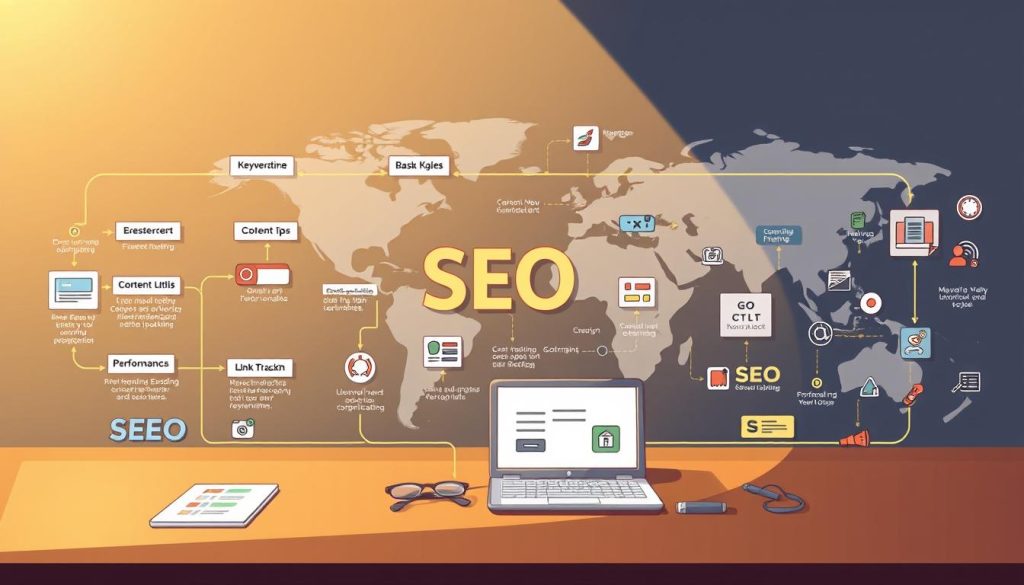In the world of digital marketing, making your website search engine-friendly is key. There are many SEO analysis tools out there. But picking the right ones can be hard. This article will show you the top on-page SEO tools for 2025.
Choosing the right website optimization tools can boost your site’s visibility. It can also help your site rank better on search engines. We’ll look at the best on-page SEO tools to help you meet your digital marketing goals.
Table of Contents
Main Objectives
- Discover the top on-page SEO tools for 2025
- Learn how to analyze and optimize your website for better search engine rankings
- Understand the importance of using specialized tools for SEO analysis
- Find out how to improve your website’s visibility and performance
- Get insights into the best practices for website optimization
Understanding On-Page SEO and Why You Need Specialized Tools
On-page SEO is key in digital marketing. It helps your web pages rank higher in search engines and boosts your site’s visibility, attracting more visitors.
The Critical Elements of On-Page SEO
The main parts of on-page SEO are keyword optimization, meta tags, and content quality. Using the right keywords in your Content is essential. Meta tags give search engines info about your page. Also, high-quality Content is vital because it adds value to your users.
How On-Page SEO Tools Improve Your Website’s Performance
SEO tools help your site perform better. They spot areas for improvement and offer tips. These tools optimize your site’s elements like meta tags and Content, helping your rankings.
On-Page SEO Element Description Importance
Keyword Optimization Using relevant keywords in your page’s Content High
Meta Tags: Providing search engines with information about your page, High
Content Quality: Providing value to your users through high-quality content High
Key Features to Look for in On-Page SEO Tools
When picking on-page SEO tools, look for certain key features. These features can significantly help your website’s optimization. A good tool should give a detailed analysis of your site’s good and bad points. This helps you make choices based on data.
Technical SEO Analysis Capabilities
A top on-page SEO tool should have technical SEO analysis capabilities. It should be able to crawl your site, find broken links, and create XML sitemaps. These features help spot and fix problems that can hurt your site’s search engine ranking.
Content Optimization Features
Good content optimization features are key for making your site more relevant and authoritative. Look for tools that offer keyword research, content ideas, and tips to improve your Content’s reach.
User Experience Metrics
User experience metrics are now crucial for SEO. They affect how search engines rank your site. Tools that show page speed, mobile friendliness, and other user experience areas can help you see where to get better.
By focusing on these features, you can find an on-page SEO tool that fits your needs. It will help you make your website better for search engines.

The Best On-Page SEO Tools for 2025
The top on-page SEO tools for 2025 help you check, fix, and boost your website’s search ranking. With so many choices, picking the right tools is key to bettering your site.
1. Semrush
Semrush is a top on-page SEO tool. It offers features such as technical SEO checks, competitor analysis, and tips for better Content.
Key Features
- Technical SEO audit
- Competitor analysis
- Content optimization
Step-by-Step Usage Guide
- Sign up for a Semrush account and set up your project.
- Do a technical SEO audit to find website problems.
- Look at your competitors and find chances to improve.
- Use content tips to make your pages better.
2. Ahrefs
Ahrefs is a strong on-page SEO tool known for its backlink and keyword research. It helps your Content rank higher.
Key Features
- Backlink analysis
- Keyword research
- Content analysis
Step-by-Step Usage Guide
- Create an Ahrefs account and set up your dashboard.
- Find relevant keywords with the keyword research tool.
- Check your backlinks and find ways to get better.
- Make your Content better based on Ahrefs’ advice.
3. Screaming Frog SEO Spider
Screaming Frog SEO Spider is a technical tool that crawls your site to find SEO problems, such as broken links and duplicate Content.
Key Features
- Website crawling
- SEO issue identification
- Data export
Step-by-Step Usage Guide
- Download and install Screaming Frog SEO Spider.
- Crawl your site to find SEO problems.
- Look at the report and fix the issues.
- Export data for more analysis.
4. Moz Pro
Moz Pro is an all-in-one SEO tool that offers keyword research, site audits, and rank tracking to help you optimize your site.
Key Features
- Keyword research
- Site audits
- Rank tracking
Step-by-Step Usage Guide
- Sign up for Moz Pro and start your campaign.
- Do keyword research to find target keywords.
- Do a site audit to find SEO issues.
- Track your rankings and adjust your strategy.
5. Google Search Console
Google Search Console is a free SEO tool from Google. It helps you watch your site’s search engine presence and find ways to get better.
Key Features
- Search engine presence monitoring
- SEO issue identification
- Sitemap submission
Step-by-Step Usage Guide
- Sign up for Google Search Console and verify your site.
- Watch your search engine presence and find issues.
- Submit your sitemap to Google.
- Fix any SEO issues you find.
6. Surfer SEO
Surfer SEO uses AI to analyze your Content. It gives you tips on how to make your Content better based on top pages.
Key Features
- Content analysis
- Optimization recommendations
- Competitor analysis
Step-by-Step Usage Guide
- Sign up for Surfer SEO and start a new project.
- Analyze your Content and find areas to improve.
- Use Surfer SEO’s tips to make your Content better.
- Keep an eye on your rankings and adjust as needed.
7. Yoast SEO
Yoast SEO is a popular WordPress plugin. It helps you optimize your site’s on-page SEO, including meta tags, content analysis, and readability checks.
Key Features
- Meta tag optimization
- Content analysis
- Readability checks
Step-by-Step Usage Guide
- Install Yoast SEO on your WordPress site.
- Optimize your meta tags and Content.
- Use Yoast’s readability checks to improve your Content.
- Keep an eye on your SEO performance and adjust as needed.
8. Clearscope
Clearscope uses AI to analyze your Content. It gives you tips to make your Content better based on relevant keywords and topics.
Key Features
- Content analysis
- Optimization recommendations
- Keyword research
Step-by-Step Usage Guide
- Sign up for Clearscope and start a new project.
- Analyze your Content and find areas to improve.
- Use Clearscope’s tips to make your Content better.
- Keep an eye on your rankings and adjust as needed.
9. PageSpeed Insights
PageSpeed Insights is a free tool from Google that checks your site’s loading speed and gives you tips for improving it.
Key Features
- Loading speed analysis
- Performance optimization recommendations
Step-by-Step Usage Guide
- Access PageSpeed Insights and enter your site’s URL.
- Analyze your site’s loading speed and find ways to improve.
- Use PageSpeed Insights’ tips to make your site faster.
- Keep an eye on your site’s performance and adjust as needed.
10. Rank Math
Rank Math is a WordPress plugin. It helps you optimize your site’s on-page SEO, including meta tags, content analysis, and schema markup.
Key Features
- Meta tag optimization
- Content analysis
- Schema markup
Step-by-Step Usage Guide
- Install Rank Math on your WordPress site.
- Optimize your meta tags and Content.
- Use Rank Math’s schema markup feature to enhance your search engine presence.
- Keep an eye on your SEO performance and adjust as needed.
How to Create a Complete On-Page SEO Workflow
Creating a good on-page SEO workflow is key to bettering your website’s search rankings. It involves several steps that boost your site’s visibility and attract more visitors.
1. Conducting a Comprehensive Site Audit
A detailed site audit is the basis of a good SEO workflow. It checks your website’s structure, Content, and tech performance for better spots. Tools like Semrush or Ahrefs help find problems like broken links and slow loading times.
2. Analyzing and Optimizing Content
Improving your Content is vital for on-page SEO. Look at your Content’s relevance, quality, and keyword use. Tools like Clearscope or Surfer SEO help make your Content better for keywords and your audience.
3. Monitoring and Maintaining Your SEO Progress
Keeping an eye on your SEO progress is key. Use tools like Google Search Console and Rank Math to watch your rankings and traffic. Regularly check your data to spot trends and make better SEO choices.
Here’s how a full-on-page SEO workflow works:
SEO ToolPrimary FunctionBenefits
Semrush Technical SEO Audit identifies technical issues and improves site crawlability.
Clearscope Content Optimization enhances content relevance and improves keyword targeting.
Google Search Console Performance Monitoring Tracks rankings, traffic, and other key SEO metrics
By using these tools in your SEO workflow, you can significantly improve your website’s search engine rankings and get more organic traffic. Always check and update your workflow to stay competitive and reach your SEO goals.
Combining Multiple On-Page SEO Tools for Better Results
Using just one on-page SEO tool might not be enough. Mixing different tools can lead to better results. This way, you can use each tool’s strengths for a more complete optimization.
Tool Integration Strategies
Choosing tools that work well together is key. For example, using Screaming Frog for technical SEO and Clearscope for content optimization is a good mix. It gives you a complete view of on-page SEO.
Cost-Effective Tool Combinations
You don’t have to spend a lot to combine tools. Tools like Google Search Console and Yoast SEO are free or cheap. Pair them with more expensive tools like Ahrefs or Semrush for a good deal.
Tool Combination Benefits Cost
Screaming Frog + Clearscope Technical SEO + Content Optimization Premium
Google Search Console + Yoast SEO Performance Monitoring + On-page Optimization Free/Low
Ahrefs + Semrush Comprehensive SEO Analysis Premium
Conclusion
Good on-page SEO is key to making your website more visible and better in search rankings. Using the right tools helps you analyze and improve your site, resulting in better results.
The tools we discussed have many features. They help with technical SEO, content optimization, and user experience. Adding these tools to your SEO work can boost your site’s performance and attract more visitors.
Remember, on-page SEO tools are vital for staying ahead in the game. By using these tools and keeping up with SEO trends, you can reach your online goals. This leads to a successful SEO outcome.



